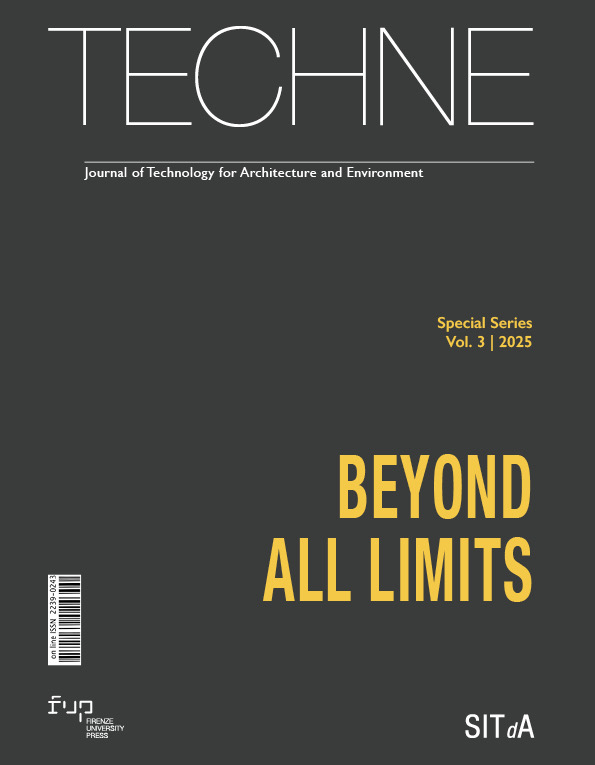Adaptive Reuse: generative matrices of environmental benefits guide the regeneration process for a comparative analysis of S. Maria in Grotta and S. Michele in Gualana
Published 2025-07-31
Keywords
- Adaptive reuse,
- Centripetal matrix,
- Centrifugal matrix,
- Planned maintenance,
- Spontaneous maintenance
How to Cite
Copyright (c) 2025 Antonio Maio

This work is licensed under a Creative Commons Attribution 4.0 International License.
Abstract
Environmental changes frequently redefine the characteristics of a monument, transforming it into an unconscious “record” and an involuntary witness to the “adaptive” processes that shape its identity over time. This paper compares two case studies that exemplify an adaptive process of conservation and rediscovery of historical heritage. The first case, with a centripetal dynamic, explores the relationship between anthropogenic interventions in the environment and their effects on built heritage, specifically the rock-hewn church of S. Maria in Grotta. The second one, with a centrifugal dynamic, addresses the redefinition of the environment by introducing new architecture, focusing on the uncovering of the rock-hewn cave of S. Michele in Gualana, which had fallen into oblivion due to the abandonment of the surrounding territory.
Downloads
References
- Amoruso, G., Battista, V. (2020), “Landscape. Bottom-Up Approach for Cultural Landscape and Local Identity Mapping”. In: Anzani, A. (Ed.), Mind and Places, Springer Series in Design and Innovation, vol 4. Springer, Cham. Available at: https://doi.org/10.1007/978- 3-030-45566-8_16
- Bullen, P.A. and Love, P.E.D. (2011), “Adaptive reuse of heritage buildings”, Structural Survey, Vol. 29 No. 5, pp. 411-421. Available at: https://doi.org/10.1108/02630801111182439 DOI: https://doi.org/10.1108/02630801111182439
- Conejos, S., Langston, C., & Smith, J. (2011),“Improving the implementation of adaptive reuse strategies for historic buildings”, Institute of Sustainable Development and Architecture, Bond University, Gold Coast, Australia
- Damla, M., Ka˘gan, G. (2016), “Adaptive reuse strategies for heritage buildings: A holistic approach”, Sustainable Cities and Society, 26 (2016) 91–98. DOI: https://doi.org/10.1016/j.scs.2016.05.017
- Della Spina, L. (2020), “Adaptive Sustainable Reuse for Cultural Heritage: A Multiple Criteria Decision Aiding Approach Supporting Urban Development Processes”, Sustainability, 12(4), 1363. Available at: https://doi.org/10.3390/su12041363 DOI: https://doi.org/10.3390/su12041363
- Ebanista, C. (2007), “L’utilizzo cultuale delle grotte campane nel Medioevo”, Atti I Convegno Regionale di Speleologia “Campania Speleologica”, 1-3 giugno 2007 Oliveto Citra (SA)
- Foster G. (2020), “Circular economy strategies for adaptive reuse of cultural heritage buildings to reduce environmental impacts”, Resources, Conservation and Recycling, 152/2020, 104507. Available at: https://doi.org/10.1016/j.resconrec.2019.104507. DOI: https://doi.org/10.1016/j.resconrec.2019.104507
- Maiuri, A. (1926), “Notizie di Scavi di Antichità, Operazioni della Reale Accademia dei Lincei”, Vol. 2, sixth series, Rome.
- Mohamed, R., Boyle, R., Yang, A.Y. and Tangari, J. (2017), “Adaptive reuse: a review and analysis of its relationship to the 3 Es of sustainability”, Facilities, Vol. 35 No. 3/4, pp. 138-154. Available at: https://doi.org/10.1108/F-12-2014-0108 DOI: https://doi.org/10.1108/F-12-2014-0108
- Oppio, A., Bottero, M., Ferretti, V. (2017), “Designing Adaptive Reuse Strategies for Cultural Heritage with Choice Experiments, in Stanghellini, S., Morano, P., Bottero, M., Oppio, A. (Ed.), Appraisal: From Theory to Practice. Green Energy and Technology, Springer, Cham. Available at: https://doi.org/10.1007/978-3-319-49676-4_23 DOI: https://doi.org/10.1007/978-3-319-49676-4_23
- Plevoets, B., and Van Cleempoel, K. (2019), “Adaptive Reuse of the Built Heritage: Concepts and Cases of an Emerging Discipline”, Routledge. Available at: https://doi.org/10.4324/9781315161440 DOI: https://doi.org/10.4324/9781315161440
- Talamo, C. (2013), “Tools and procedures for a ‘maintenance oriented’ design for buildings of worship”, TECHNE – Journal of Technology for Architecture and Environment, (6), pp. 117–124. Available at: https://doi.org/10.13128/Techne-13464.
- Violano, A. and Maio, A. (2024), “The generation of Architectural Heritage to Manage the Reversibility of Adaptive Reuse Technology Design: Two Italian case studies” in Battisti, A. and Baiani, S. ( Ed.), ETICHS, Endorse Technologies foe Heritage Innovation Designing Environments, Springer, Cham, pp. 209-226. Available at: https://doi.org/10.1007/978-3-031-50121-0_13 DOI: https://doi.org/10.1007/978-3-031-50121-0_13
- Violano, A., Muzzillo, F. and Hui, D. (2024), “Europe vs Hong Kong partnership agreements: reversing trends”, TECHNE – Journal of Technology for Architecture and Environment, (28), pp. 60–73. Available at: https://doi.org/10.36253/techne-15913. DOI: https://doi.org/10.36253/techne-15913





